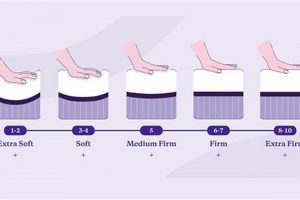The suitability of a firm sleep surface for those who prefer sleeping on their side is a subject of considerable debate. While firmness in a mattress can offer support, its impact on spinal alignment and pressure point relief for side sleepers is a key consideration. A surface that is too firm may not allow the shoulder and hip to sink in sufficiently, potentially leading to discomfort and improper spinal posture.
Selecting the correct mattress firmness plays a crucial role in promoting restful sleep and minimizing the risk of musculoskeletal issues. Historically, firm mattresses were often recommended for general back support. However, modern understanding emphasizes individualized needs based on sleeping position and body type. The potential benefits of a more compliant surface for alleviating pressure on the joints of side sleepers have gained increasing recognition in recent years.
The following discussion will delve into the specific factors that determine whether a firm mattress is a viable option for side sleepers. Factors such as body weight, mattress construction, and the individual’s specific comfort preferences all contribute to the overall suitability of a sleep surface. Evaluating these elements allows for a more informed decision regarding mattress selection, ultimately promoting optimal sleep quality and physical well-being.
Evaluating Mattress Firmness for Side Sleepers
Selecting a mattress appropriate for side sleeping necessitates careful consideration. The following guidelines assist in determining the suitability of a firm sleep surface for this position.
Tip 1: Assess Spinal Alignment. Lie on the mattress in a side sleeping position. Have a partner observe the alignment of the spine. Ideal alignment maintains a straight line from the head to the hips, indicating adequate support and contouring.
Tip 2: Consider Body Weight. Individuals with lower body weight may find firm mattresses excessively rigid, resulting in pressure point discomfort. Those with higher body weight may require a firmer surface for adequate support.
Tip 3: Evaluate Shoulder and Hip Accommodation. A firm mattress must allow sufficient sinkage for the shoulder and hip to prevent undue pressure and maintain spinal alignment. If these areas feel excessively compressed, a softer option may be preferable.
Tip 4: Examine Mattress Construction. Hybrid mattresses, which combine innerspring cores with foam or latex comfort layers, can offer a balance of support and pressure relief. A firm mattress with a softer comfort layer might be a suitable compromise.
Tip 5: Review Trial Periods and Return Policies. Most reputable mattress retailers offer trial periods, allowing consumers to test the mattress at home. Carefully review return policies to ensure the option to exchange the mattress if it proves unsuitable.
Tip 6: Consult Professional Guidance. Individuals experiencing chronic pain or discomfort should seek guidance from a healthcare professional or sleep specialist. They can provide personalized recommendations based on specific medical conditions and sleeping habits.
Proper mattress selection is crucial for maintaining spinal health and promoting restful sleep. By carefully evaluating these factors, individuals can make an informed decision about mattress firmness and optimize their sleep experience.
The ensuing sections will explore alternative mattress types and their suitability for side sleepers, providing a comprehensive overview of sleep surface options.
1. Spinal Alignment
Spinal alignment is paramount when assessing mattress suitability for side sleepers. A firm mattress may compromise this alignment if it fails to accommodate the natural curvature of the spine in the lateral position. The cause-and-effect relationship here is straightforward: insufficient contouring on a firm surface can force the spine out of its neutral position, leading to muscle strain and potential long-term discomfort. For side sleepers, the shoulders and hips bear a significant portion of the body’s weight; if a firm mattress does not allow these areas to sink slightly, the spine is subjected to unnatural angles.
Maintaining proper spinal alignment is a critical component of overall sleep health. A mattress that effectively supports the spine reduces pressure on intervertebral discs and minimizes the risk of nerve compression. For example, an individual with scoliosis who sleeps on an overly firm mattress might experience increased pain due to the exacerbation of spinal curvature. Conversely, a mattress that conforms to the body’s contours, while still providing support, can help maintain the natural spinal alignment and alleviate pressure points. The practical significance of understanding this connection lies in the ability to proactively select a mattress that promotes optimal spinal health, reducing the likelihood of sleep-related pain and discomfort.
In summary, while a firm mattress might offer support, its impact on spinal alignment for side sleepers requires careful evaluation. The key challenge is finding a balance between firmness and contouring to ensure the spine remains in a neutral position throughout the night. A failure to achieve this balance can lead to musculoskeletal issues and a reduction in sleep quality, underscoring the importance of prioritizing spinal alignment in mattress selection for side sleepers.
2. Pressure Relief
Pressure relief is a critical consideration when evaluating the suitability of a firm mattress for side sleepers. A firm sleep surface, by its inherent nature, may lack the necessary compliance to adequately distribute body weight, leading to concentrated pressure on prominent bony areas such as the shoulders and hips. The cause-and-effect relationship is direct: reduced surface give results in increased force exerted per unit area, potentially causing discomfort, restricted blood flow, and disrupted sleep. This deficiency in pressure relief becomes particularly pronounced for side sleepers, whose weight is primarily concentrated on a smaller surface area compared to back or stomach sleepers. The importance of pressure relief as a component of appropriate mattress selection for side sleepers cannot be overstated; its absence directly undermines sleep quality and may contribute to the development of pressure sores or exacerbate existing musculoskeletal conditions. An individual with arthritis, for example, will experience significantly increased pain on a firm mattress that fails to conform to the body’s contours and alleviate pressure on sensitive joints.
The practical significance of understanding this connection lies in the ability to select mattresses that incorporate materials designed to mitigate pressure points. Memory foam and latex, for instance, are often employed as comfort layers to enhance pressure relief.
These materials deform under load, distributing weight more evenly across the mattress surface. Hybrid mattresses combining innerspring support with a pressure-relieving comfort layer represent a common strategy to address this issue. Furthermore, the density and thickness of the comfort layer directly impact its pressure-relieving capabilities. A thicker, higher-density memory foam layer will generally offer superior pressure relief compared to a thinner, less dense alternative. The integration of zoned support systems, where different areas of the mattress offer varying levels of firmness, can further optimize pressure relief by providing targeted cushioning to the shoulders and hips while maintaining support for the torso.
In summary, the connection between pressure relief and the suitability of a firm mattress for side sleepers is characterized by a potential trade-off between support and comfort. While a firm mattress may offer adequate spinal support for some, its inherent lack of compliance can compromise pressure relief, particularly at the shoulders and hips. The challenge lies in identifying mattresses that strike an appropriate balance between firmness and pressure-relieving properties. This requires careful consideration of mattress construction, material composition, and individual sleep preferences. Prioritizing pressure relief is essential for side sleepers seeking to minimize discomfort and promote restful sleep, underscoring the need for thorough assessment and, ideally, a trial period to evaluate mattress performance.
3. Shoulder Comfort
Shoulder comfort is a crucial determinant when evaluating the suitability of a firm mattress for side sleepers. The extent to which a sleep surface accommodates the shoulder’s natural contours significantly impacts overall comfort and sleep quality. A mattress that fails to provide adequate space or cushioning for the shoulder can lead to pressure build-up, discomfort, and restricted circulation, ultimately disrupting sleep patterns. Understanding the factors that influence shoulder comfort is thus essential in assessing whether a firm mattress aligns with the needs of a side sleeper.
- Shoulder Width and Sinkage
The width of an individual’s shoulders directly influences the required degree of sinkage into the mattress. A broader shoulder necessitates greater accommodation to maintain spinal alignment. If a firm mattress lacks sufficient give, the shoulder is forced to bear excessive weight, leading to pressure point formation. For instance, an athlete with well-developed shoulder muscles may experience significant discomfort on a firm mattress, requiring a more compliant surface that allows the shoulder to recess comfortably. Inadequate sinkage contributes to shoulder impingement and rotator cuff issues.
- Mattress Material and Responsiveness
The composition of the mattress plays a pivotal role in shoulder comfort. Materials such as memory foam and latex possess inherent contouring properties, conforming to the body’s shape and distributing weight more evenly. A firm mattress constructed solely from high-density foam may lack this responsiveness, resulting in localized pressure on the shoulder. Hybrid mattresses, which combine a supportive innerspring core with a comfort layer of memory foam or latex, can offer a balance between support and pressure relief. The type and thickness of the comfort layer significantly impact its ability to alleviate shoulder pressure. A thin or low-density comfort layer may prove insufficient, negating any potential benefits.
- Sleeping Position Variations
Even within the broader category of side sleeping, subtle variations in sleeping position can impact shoulder comfort. Some individuals may prefer a more fetal position, while others adopt a straighter posture. These nuances influence the pressure distribution on the shoulder. A firm mattress might be tolerable for those who sleep with their arm extended, distributing pressure over a larger area. However, individuals who sleep with their arm tucked under their pillow or body may experience increased discomfort due to concentrated pressure on the shoulder joint. Adjusting pillow height and placement can mitigate some of these issues, but the underlying mattress firmness remains a primary factor.
- Spinal Alignment and Neck Support
Shoulder comfort is inextricably linked to spinal alignment and neck support. A firm mattress that elevates the shoulder excessively can misalign the spine, leading to neck pain and stiffness. Conversely, a mattress that allows the shoulder to sink too deeply can create a similar misalignment. Maintaining proper spinal alignment requires a delicate balance between support and contouring. The pillow plays a crucial role in complementing the mattress, providing adequate neck support to maintain a neutral spinal position. An improperly sized or positioned pillow can exacerbate shoulder discomfort, even on a mattress that is otherwise well-suited.
In summary, the attainment of shoulder comfort is inextricably tied to the judicious selection of a mattress that accommodates the specific needs of a side sleeper. A firm mattress, while potentially offering adequate support, must also possess the capacity to alleviate pressure on the shoulder joint. This necessitates careful consideration of mattress materials, sleeping position variations, and the intricate interplay between spinal alignment and neck support. By prioritizing these aspects, individuals can enhance their sleep quality and mitigate the risk of shoulder-related discomfort. Ultimately, a successful mattress choice reflects a nuanced understanding of individual needs and the complex relationship between sleep surface characteristics and musculoskeletal health.
4. Hip Support
Hip support represents a crucial determinant of mattress suitability, particularly for side sleepers. The alignment of the spine, which is essential for restful sleep and long-term musculoskeletal health, is directly influenced by the degree to which a mattress supports the hips. A firm mattress, while potentially providing overall support, may not sufficiently accommodate the natural curvature of the spine in the side sleeping position, particularly if it fails to allow adequate sinkage for the hip joint. This can lead to misalignment, causing pressure points, muscle strain, and discomfort. For instance, an individual with pre-existing hip pain, such as bursitis or arthritis, may experience exacerbated symptoms on a firm mattress that does not adequately cushion and support the hip. The lack of proper hip support necessitates that the surrounding muscles work harder to maintain spinal stability, resulting in fatigue and potential pain.
Achieving optimal hip support necessitates a careful consideration of mattress construction and material properties. Mattresses incorporating memory foam or latex, renowned for their conforming capabilities, are often recommended for side sleepers. These materials distribute weight more evenly, reducing pressure on the hip joint and promoting spinal alignment. Furthermore, the thickness and density of the comfort layer directly impact its ability to provide effective hip support. A thicker, higher-density layer will generally offer greater cushioning and weight distribution compared to a thinner, less dense alternative. Zoned support systems, where different sections of the mattress offer varying degrees of firmness, can further opt
imize hip support by providing targeted cushioning to the hip area while maintaining support for other areas of the body. The integration of features such as reinforced edge support can also be beneficial, preventing excessive sinkage at the edges of the mattress and ensuring consistent support across the entire sleep surface.
In summary, the relationship between hip support and the suitability of a firm mattress for side sleepers is complex and multifaceted. While a firm mattress may offer adequate overall support, its potential to compromise hip alignment and pressure distribution must be carefully considered. Prioritizing proper hip support through thoughtful mattress selection is essential for side sleepers seeking to minimize discomfort, maintain spinal health, and promote restful sleep. The challenge lies in finding a mattress that strikes an appropriate balance between firmness and conformity, effectively cushioning and supporting the hip while maintaining overall spinal alignment. Individuals with pre-existing hip conditions should consult with a healthcare professional or sleep specialist to obtain personalized recommendations tailored to their specific needs and medical history.
5. Body Weight
Body weight significantly influences the appropriateness of a firm mattress for side sleepers. The relationship is characterized by a need for balanced support and pressure distribution. Individuals with higher body weights exert more force on the mattress surface, potentially requiring a firmer sleep surface to prevent excessive sinkage and maintain spinal alignment. Conversely, individuals with lower body weights may find a firm mattress too rigid, resulting in concentrated pressure on the shoulders and hips, leading to discomfort. A cause-and-effect relationship exists between body weight, mattress firmness, and spinal alignment. Insufficient support for heavier individuals can lead to spinal misalignment, while excessive firmness for lighter individuals can create pressure points. The individual’s body weight is, therefore, a critical component in determining the suitability of a particular mattress firmness level.
Practical examples underscore this connection. A person weighing 250 pounds who sleeps on their side may find that a firm mattress provides the necessary support to prevent their spine from curving excessively. This alignment reduces pressure on the intervertebral discs and promotes restful sleep. However, a person weighing 130 pounds using the same mattress may experience shoulder and hip pain due to the lack of contouring. The mattress’s rigidity fails to distribute their body weight effectively. As a result, the mattress exerts pressure on specific points, hindering blood circulation and disrupting sleep patterns. The practical application lies in selecting a mattress firmness level that corresponds to the individual’s weight and sleeping position. Memory foam toppers or mattresses with zoned support systems offer potential solutions for achieving the correct balance.
In summary, body weight is a key factor in determining whether a firm mattress is appropriate for side sleepers. Consideration of body weight in conjunction with factors such as spinal alignment, pressure relief, and personal preference allows for a more informed decision regarding mattress selection. The challenge lies in finding a mattress that provides adequate support without sacrificing comfort, requiring a careful assessment of individual needs and mattress characteristics. The ultimate goal is to optimize sleep quality and promote long-term musculoskeletal health.
6. Mattress Construction
The architecture of a mattress, encompassing its materials and assembly, plays a pivotal role in determining its suitability for side sleepers. The interaction between different layers and components influences pressure distribution, spinal alignment, and overall comfort, directly impacting the question of whether a firm mattress is a viable option for this sleep position.
- Core Support System
The core support system, typically consisting of innersprings or high-density foam, provides the foundation for the mattress. Innerspring systems offer varying degrees of firmness and support based on coil gauge and density. High-density foam cores provide uniform support and resist compression over time. A firm mattress with a robust core support system may be beneficial for side sleepers who require substantial spinal support, particularly those with higher body weights. However, without adequate contouring in the upper layers, a firm core can lead to pressure points at the shoulders and hips.
- Comfort Layer Materials
The comfort layer, situated above the core support system, is responsible for providing cushioning and pressure relief. Materials such as memory foam, latex, and polyfoam are commonly used in comfort layers, each possessing distinct characteristics. Memory foam conforms closely to the body, distributing weight and alleviating pressure points. Latex offers a responsive feel and is known for its durability. Polyfoam provides a more affordable option but may not offer the same level of contouring as memory foam or latex. The thickness and density of the comfort layer are critical determinants of its pressure-relieving capabilities. A firm mattress paired with a thin or low-density comfort layer may prove unsuitable for side sleepers, as it fails to adequately cushion the shoulders and hips.
- Zoned Support Systems
Zoned support systems involve variations in firmness across different sections of the mattress to provide targeted support and pressure relief. For instance, a mattress may feature a firmer center section to support the torso and prevent spinal sagging, while the shoulder and hip areas are softer to allow for greater contouring. This design can be particularly beneficial for side sleepers, as it allows for proper spinal alignment without sacrificing comfort. A firm mattress incorporating a well-designed zoned support system can offer a compromise between support and pressure relief, potentially making it a suitable option for some side sleepers.
- Hybrid Construction
Hybrid mattresses combine the features of innerspring and foam mattresses, integrating a coil-based support system with a comfort layer of memory foam, latex, or other materials. This construction aims to provide a balance of support, pressure relief, and responsiveness. Hybrid mattresses can offer a firmer feel compared to all-foam mattresses while still providing adequate contouring for side sleepers. The effectiveness of a hybrid mattress for side sleepers depends on the specific materials used and the thickness of the comfort layer. A hybrid mattress with a substantial comfort layer and a supportive coil system can potentially provide the necessary support and pressure relief for side sleepers, even with an overall firmer feel.
In conclusion, mattress construction profoundly influences whether a firm mattress proves suitable for side sleepers. While a firm core support system can provide essential spinal support, the comfort layer and the presence of zoned support or hybrid construction are critical for achieving pressure relief and contouring. Careful consideration of these elements is essential when evaluating the suitability of a firm mattress for individuals who primarily sleep on their side.
7. Personal Preference
Individualized comfort perceptions exert considerable influence over mattress selection, often outweighing generalized recommendations. While biomechanical principles offer guidance on spinal alignment and pressure relief, the subjective experience of comfort ultimately determines user satisfaction. The suitability of a firm mattress for side sleepers is therefore contingent on personal preference as a primary factor.
- Tolerance for Pressure
Individuals exhibit varying sensitivities to pressure. Some side sleepers may find the lack of contouring in a firm mattress intolerable, experiencing discomfort in the shoulders and hips. Others may perceive this firmness as supportive, preferring the feeling of being “on top” of the mattress rather than “sinking in.” This tolerance is influenced by factors such as body composition, existing musculoskeletal conditions, and prior experience with different mattress types. For instance, an individual accustomed to sleeping on a traditional innerspring mattress may initially find a memory foam mattress overly soft, even if it provides objectively better spinal alignment.
- Perceived Support and Stability
The perception of support is highly subjective. Some side sleepers equate firmness with support, believing that a firmer mattress provides greater spinal stability. Conversely, others may perceive a softer mattress as more supportive, particularly if it conforms to their body’s contours and alleviates pressure points. The ideal level of support often depends on individual body weight and sleep posture. Heavier individuals may require a firmer mattress to prevent excessive sinkage, while lighter individuals may find a softer mattress provides adequate support and pressure relief. Ultimately, the perception of support is a critical factor in determining whether a side sleeper finds a firm mattress comfortable.
- Temperature Sensitivity
Mattress firmness can indirectly influence temperature regulation, which can impact personal comfort. Firmer mattresses may promote greater airflow compared to softer mattresses, reducing heat retention. Individuals who tend to sleep hot may find a firm mattress more comfortable, even if it does not provide optimal pressure relief. Conversely, individuals who are sensitive to cold may prefer a softer mattress that conforms more closely to their body, trapping heat and providing a warmer sleeping environment. This interplay between firmness and temperature sensitivity highlights the subjective nature of mattress selection.
- Habituation and Psychological Factors
Prior experience and psychological factors can significantly influence mattress preference. An individual who has consistently slept on firm mattresses may develop a preference for this level of firmness, even if it is not objectively the best choice for their sleeping position. Psychological associations with firmness, such as a perception of durability or back support, can also play a role. Conversely, an individual who has had negative experiences with firm mattresses may be predisposed to prefer softer options. These factors underscore the importance of considering individual history and psychological associations when evaluating mattress suitability.
While biomechanical principles provide valuable guidance in mattress selection, personal preference remains a paramount consideration. Factors such as pressure tolerance, perceived support, temperature sensitivity, and psychological associations collectively shape the individual’s subjective experience of comfort. Therefore, determining whether a firm mattress is suitable for a side sleeper requires a nuanced assessment of both objective criteria and individual preferences. A trial period, where possible, allows for a more informed decision, enabling the individual to assess their comfort level over an extended period and make an informed choice based on their own experience.
Frequently Asked Questions
The following addresses common inquiries regarding the suitability of firm mattresses for individuals who primarily sleep on their side. The information presented aims to provide clarity and guide informed decision-making.
Question 1: Is a firm mattress inherently detrimental to side sleepers?
A firm mattress is not automatically unsuitable. Suitability depends on factors such as body weight, spinal alignment, and individual pressure tolerance. If the mattress allows for adequate shoulder and hip sinkage to maintain a neutral spinal position, a firm mattress can be acceptable.
Question 2: How does body weight influence the choice between a firm and softer mattress for side sleepers?
Individuals with higher body weights may require a firmer mattress to prevent excessive sinkage and maintain spinal alignment. Conversely, those with lower body weights may find a firm mattress excessively rigid, resulting in pressure point discomfort. A balanced approach is crucial.
Question 3: What mattress construction features are most important for side sleepers considering a firm mattress?
The comfort layer composition is paramount. A firm mattress with a substantial comfort layer of memory foam or latex can provide adequate pressure relief at the shoulders and hips. Zoned support systems, offering varying levels of firmness, can also enhance comfort.
Question 4: Can spinal alignment be maintained on a firm mattress while side sleeping?
Maintaining spinal alignment requires careful evaluation. The mattress must allow the shoulder and hip to sink sufficiently to prevent the spine from being forced out of its natural alignment. A partner can assist in observing spinal alignment while the individual is lying on their side.
Question 5: Are there specific medical conditions that contraindicate the use of a firm mattress for side sleepers?
Individuals with conditions such as arthritis, bursitis, or scoliosis may experience exacerbated symptoms on a firm mattress that fails to provide adequate pressure relief and spinal support. Consultation with a healthcare professional is recommended.
Question 6: How can pressure points be minimized when using a firm mattress for side sleeping?
Pressure points can be mitigated by using a mattress topper made of memory foam or latex. Adjusting pillow height to ensure proper neck support can also alleviate shoulder pressure. Regular repositioning during sleep is another strategy.
The selection of a mattress is a highly individualized process. These answers are intended to provide general guidance, not definitive medical advice. Trial periods and professional consultations are encouraged to ensure the chosen mattress meets individual needs and preferences.
The following section will explore alternative mattress types and their respective advantages and disadvantages for side sleepers.
Concluding Remarks
The determination of whether a firm mattress proves suitable for side sleepers remains a nuanced issue. This exploration has highlighted the multifaceted considerations involved, encompassing spinal alignment, pressure relief, body weight, mattress construction, and personal preference. While a firm surface can offer adequate support for some, its potential to compromise pressure distribution, particularly at the shoulders and hips, warrants careful evaluation. The absence of sufficient contouring may lead to discomfort and disrupted sleep cycles. Ultimately, the appropriateness hinges on achieving a delicate equilibrium between support
and pressure alleviation, necessitating a comprehensive understanding of individual needs and mattress characteristics.
The information presented serves as a foundation for informed decision-making. Individuals are encouraged to critically assess their specific circumstances, consult with healthcare professionals when necessary, and, whenever possible, utilize trial periods to thoroughly evaluate mattress performance. The pursuit of optimal sleep quality represents a significant investment in long-term health and well-being, meriting careful consideration and personalized solutions. The ongoing evolution of mattress technology promises further advancements in customization and support, offering increased opportunities for achieving restful and restorative sleep for all individuals, regardless of their preferred sleep position.







